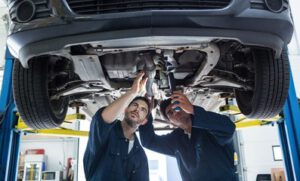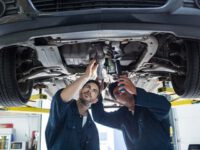Why Car Services Are Important
Car servicing is essential for maintaining your vehicle and avoiding expensive repair bills in the future. Taking care of small issues early on can also help reduce the cost of fuel.

A basic service will include a visual inspection, an oil and filter change, and topping up the critical fluids (antifreeze, brake fluid, washer fluid, and steering fluid). A full service involves more in-depth maintenance, and up to 35 key components are checked.
Car services are important to help your vehicle run smoothly and efficiently. They also protect your investment and maintain the value of your car, which is especially important if you are thinking about selling it at some point. Regular car services ensure that all of the necessary components are working as they should and help to avoid costly repairs in the future.
Minor car services are usually carried out every 10,000 kilometers, though this can vary depending on the manufacturer and your driving style. In addition to an oil change, a minor service will also include a full inspection of the engine and its components. The technician will look at the condition of the filter, air, and fuel, as well as check all fluid levels and tires.
A major service will usually occur at 30,000-kilometer intervals, although this can vary depending on the make and model of your car as well as your mechanic’s recommendations. This is the time when your technicians will replace the spark plugs and all filters, ensuring that your engine is operating as it should.
This is also a good opportunity for the technicians to inspect the transmission and differential gears, which transfer power from the drive shaft to your wheels. If these are not in good condition, it can cause the engine to work harder, consuming more energy and leading to decreased fuel efficiency.
During this process, your mechanic will replace the transmission and differential fluids to keep these crucial components lubricated. This will reduce friction and allow your engine to work more effectively, using less energy and reducing wear on parts.
The mechanic will also check the tires to make sure that they are correctly inflated and have sufficient tread depth to be safe for driving. He may also rotate your tires to ensure even wear, but this will be an extra charge.
The technician will also give the battery a test to ensure that it starts the car and check the wipers, washers, and lights. He will also re-check the air conditioning system to ensure that it is working as it should and test the response of the brakes and suspension.
Major Service
If your car is due for a major service, this usually means it is time to give it the attention it deserves. It will probably need a new air filter, spark plugs, and oil. The mechanic will also flush and replace the transmission, clutch, brake, and power steering fluids. The battery will be tested and replaced if necessary. A road test is carried out to check the performance and safety of the vehicle.
A major service is much more in-depth than a basic or full car service, and it includes 60 checks from head to tail. It also includes a detailed inspection of all the electronics in the vehicle, including the AC and radio. The mechanic will also look at the wheels and tires.
The brakes will be checked, and the timing belt may need to be changed if it is due for replacement. A major service is more expensive than the other two types of car service, and it should be booked well in advance to ensure that you can find a suitable garage.
Keeping on top of the maintenance of your car is essential for its reliability and longevity. It will keep you safer on the roads, and it will improve the resale value of your vehicle in the future. You should take your car in for a maintenance service at least once a year, or more often if your owner’s manual suggests it.
Despite the fact that it can be expensive to service your vehicle, it is better to pay for a car service now than to face costly repairs in the future. Most modern vehicles have a service light on the dashboard that alerts drivers when they need a car service, but it is always good to follow the manufacturer’s recommended schedule to avoid unexpected breakdowns. You should always check the terms and conditions of a car service plan before you book it, as they vary from garage to garage. You should also ask for a log of all the work that has been completed, so you can understand what is included and what is not.
MOT
Cars must undergo an MOT test once a year to make sure they’re roadworthy. These tests analyze a number of different aspects, from the tires and suspension to the headlights and indicators. They’re carried out at a garage or MOT testing center that is licensed to carry them out. These centers can range from local independent garages to national chains like Kwik Fit and Halfords.
If your car fails its MOT, it can be repaired and retested later that same day. This will incur a fee, which depends on the severity of the faults found. Generally, the more serious the fault, the higher the fee. If the repairs are more minor, there may be no fee at all.
An MOT can also reveal so-called “advisories” that aren’t severe enough to cause a fail but are issues that will need attention in the near future. These are basically warnings, such as tires that will need replacing soon due to their minimum legal tread depth or brake pads that are beginning to wear down.
A good MOT will also check that your vehicle has the correct fuel type and hasn’t been tampered with, as this could result in a failure. The number plates should be readable, and the windshield wipers should have no holes or tears. The horn should work and be loud enough to attract the attention of other road users. Finally, the examiner will check that the seatbelts are secure and working properly and that there are no lights on in the boot that shouldn’t be.
Whether you have a full service or an MOT included in your car’s servicing, it’s worth remembering that it’s best to prevent problems rather than wait for them to happen. Regular servicing can keep your car in the best possible shape, prolong its life, and optimize its resale value should you decide to sell it.
Keep an eye out for the MOT reminder in your vehicle’s handbook, and book your car in for its next service at least a month before it’s due. This will give the mechanic plenty of time to perform any necessary checks and repairs before the MOT is due, which can help ensure it passes with flying colors.
Oil Change
Motor oil is the lifeblood of your car’s engine. It lubricates the moving parts to prevent friction and reduce heat, and it also removes harmful particles from the engine. It needs to be changed regularly to keep your engine working properly.
During an oil change, the technician will remove your old oil and replace it with new, clean motor oil. They may also replace your oil filter. The type of oil you need depends on your vehicle’s engine size, and the manufacturer’s specifications can usually be found in your owner’s manual.
When changing the oil, it is important to not overfill it. Overfilling can damage your engine and create a mess. If you notice that the oil level is low between changes, it is a good idea to top it off yourself instead of bringing your car in for an oil change.
A good car service will take the time to inspect your engine, transmission, brakes, and other critical components of your car. They will also check your lights, tires, and other essential fluids. They will usually ask you questions about your driving habits, including how and where you drive on a regular basis. This information will help them determine the best way to care for your vehicle.
If your car is a newer model, it may have an onboard oil monitoring system that alerts you when it is time for an oil change. These systems can be a great way to save time, money, and hassle. However, you should still bring your car in for routine oil changes at the recommended intervals.
An oil change is one of the most basic services that any automotive shop can offer. It is relatively inexpensive, and it can be done at a quick lube, auto repair shop, or dealership. The main difference between a quick lube and a dealer is that the dealer has technicians who have received specialized training on your specific vehicle. This means they are better equipped to identify other repairs, maintenance items, and open safety recalls that may affect your car.






